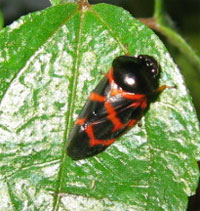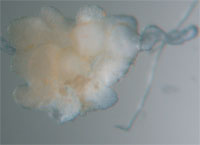We have moved to a new server!
Since March 2014, this website has been moved to this new server: http://web.ntnu.edu.tw/~treehopper/. This page will not be updated anymore. Please update your browser’s bookmark or the web links.
Member list
Current members
- Jo-Fan Wang
- 1. The Territorial Behavior of Euphaea formosa (Odonata). 2. Tempo and Mode of Pronotal Evolution in Membracis Treehoppers.
- Hung-Nien Chen
- 1. The effect of typhoon on survivalship of Matrona cyanoptera. 2. Modes of phenotypic variation in Euphaea amphicyana.
- Lan-Wai Yeh
- Ecology and evolution of Taiwanese Carabus ground beetles.
- Yun-Chieh Cheng
- What do damselfly larvae eat? DNA barcode analyses of larval diet in Matrona cyanoptera and Euphaea formosa.
- Chung-Hsin Huang
- Flucuating Asymmetry and Developmental Asymmetry of Cyclommatus mniszechi.
- Hui-Yun Tseng
- 1. Biological function of coloration in Pachyrrhynchus tobafolius. 2. Phylogeny and color evolution of Pachyrrhynchus weevils. 3. Population genetics of Pachyrrhynchus weevils on Lanyu and Green Island.
- I-Ting Hsiao
- Variation of genitalia in Euphaea amphicyana.
- Yen-Ting Chen
- The effect of forest management of Mt. Da-Shiue on the morphological variation of a ground beetle, Carabus (Apotomopterus) masuzoi.
- Jyun-Huei Huang
- The fighting behavior of a stag beetle, Rhaetulus crenatus.
- Shi-Ting Wu
- Membracis Phyllotropis.
- Chiao-Wei Lin
- The fighting behavior of a stag beetle, Rhaetulus crenatus.
- Yong-Chao Su
- Behavioral ecology, sociobiology, population genetics, and molecular phylogenetics.
Past members
- Wei-Liang Xiao
- Variation of wing veins in Euphaea amphicyana.
- Li-Wen Weng
- Why do firefly larvae emit light?
- Yat-Hung Lee
- Speciation of Euphaea damselflies.
- Che-Yu Kuan
- Variation of mandibles in stag beetles.
- Chu-Yen Cheng
- Phylogeography of a Philippine's treehopper, Leptocentrus reponens.
- Ming-Yu Chen
- Phylogeography and population history of the treehoppers, Centrochares horifficus from the Philippines Archipelago.
- Shao-Chang Huang
- Visual Communication of Matrona cyanoptera
- Jen-Pan Huang
- Population Genetics and Phylogeographic Analyses of Formosan Damselfly, Euphaea Formosa (Insecta: Odonata: Euphaeidae) from Taiwan
- Wei-Yun Chen
Visiting scholars and students
- Vanitha Williams
- Predatory potential of waterbug, Diplonychus rusticus and dragonfly, Diplacodes trivialis on mosquito larvae.
- Marina Vilenica
- Dragonfly composition (Insecta, Odonata) in wetland area of Turopolje region, Croatia
- Klaas-Douwe 'KD' B. Dijkstra
- History, diversity and identification of dragonflies and damselflies (Odonata).
- Erin McCullough
- " Diversification of weapon form: aerodynamic costs of beetle horns.
- Ashley E. King
- Intrasexual combat and intersexual antagonistic co-evolution in horned beetles.
Wei-Yun Chen

Title
Master student 2005-2008
Species: Okiscarta uchidae

Project
Molecular and Phylogenetic Characterization of Endosymbiotic Bacteria of the Froghopper, Okiscarta uchidae (Insecta: Hemiptera: Cercopidae)
Abstrct
E-mail:weiyun33@gmail.com
1. Bacterial Symbionts in the Red Striped Spittlebug, Okiscarta uchidae
Symbiotic life style is a major adaptation of organisms that can increase their diversity. Many insects, especially hemipterans, are associated with the primary as well as secondary endosymbionts. The primary endosymbiont (bacteriome associated) of insects provides their hosts with nutrition whereas the function of secondary endosymbionts is not clear. Here we used molecular phylogenetic analyses to describe the characteristics of bacterial endosymbionts in the red striped spittlebug, Okiscarta uchidae, and to investigate their phylogenetic placement within the eubacteria. We also evaluated relative evolutionary rates of endosymbionts and their free-living and pathogenic relatives. TEMs suggested that there were at least two types of endosymbionts in the bacteriomes, one of them are bacterial symbionts and the other are yeast-like organisms. Phylogenetic results suggested that there are four distinct symbiont lineages, three of them belonging to γ-proteobacteria and the other one clustered witnin the phylum Bacteroidetes. Results obtained from in situ hybridization suggested that five of the isolated endosymbionts were located inside the bacteriomes. In this study, we found that the evolutionary rates of identified symbionts were frequently the lowest among free-living, pathogenic and symbiont bacteria of insects, suggesting that they are most likely to be the “secondary” endosymbionts of O. uchidae.

Bacteriome of O. uchidae
2. Cospeciation of Spittlebugs and their Primary β-Proteobacterial Endosymbionts
Most organisms have evolved mutualistic relationships with other genetic entities. Many insects hemipterans, harbor primary or obligate endosymbionts found inside the bacteriomes, which are tissues specialized for housing bacteria. Spittlebugs are unique among hemiptran insects because they primarily feed on xylem sap, which is the most nutritionally limited diet. Thus spittlebugs were considered to host a large number of diverse bacterial symbionts in bacteriomes. As a consequence of their vertical transmission, the primary endosymbionts were expected to cospeciate with their insect hosts.Our study examined the pattern of cospeciation between a group of newly identified obligate endosymbionts and their cercopid hosts using phylogenetic analyses. According to our analyses, the primary endosymbionts of spittlebugs formed a monophyletic group were clustered phylogenetically within gram-negative, β- proteobacteria. Five cospeciation events occured non-randomly when comparing the phylogenies of endosymbionts and their hosts. Bayesian relative rate analyses indicated hosts and their endosymbionts evolve at the same rate and likely to speciate at the same time. Our results suggest that this lineage of symbiont species in spittlebugs is the primary endosymbionts which cospeciated with their insect hosts.
Present address:
USA